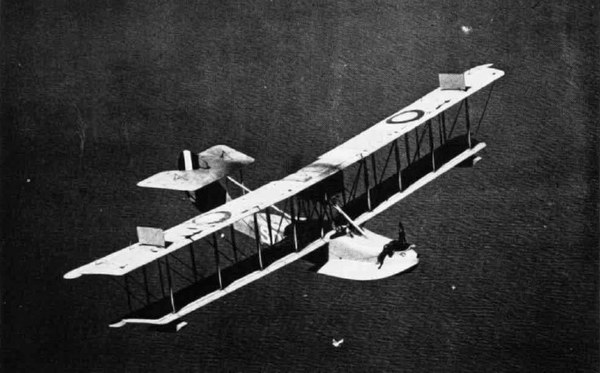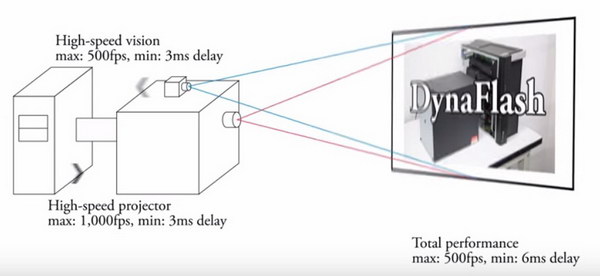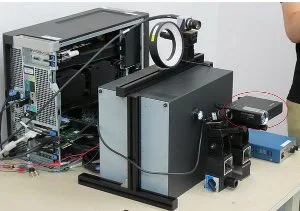Researcher Gaku Narita and his colleagues at Ishikawa Watanabe Laboratory at the University of Tokyo and Tokyo Electron Device Ltd. co-developed a high-speed projector capable of projecting images with a frame rate of 1,000 fps. Information on the system, called DynaFlash by the researchers, was posted online on July 28.

The DynaFlash system includes a high-speed camera capable of 500 frames per second (fps) and with a 3mS latency which was coupled to a monochrome DLP projector with 8 bits of grey scale and XGA resolution (1,024 x 768) operating at 1000 fps with an additional 3mS latency. This gives the overall system a 500 fps operation rate with a 6ms latency.
 Prototype DynaFlash system, with the DLP microprojector used circled in red.
Prototype DynaFlash system, with the DLP microprojector used circled in red.
The purpose of the system is to allow projection mapping on fast moving surfaces. The camera will track the moving system and the image will remain in the same location on the object as the object moves.
Motion tracked projection mapping has become a standard technique in rental and staging shows. Perhaps the best known applications of projection mapping use static objects as the projection targets. These static targets include, for example, large buildings with multiple 40,000 lumen projectors showing images on the building’s facade. But moving objects are becoming more common as projection mapping targets at venues such as product introductions, trade shows, Broadway musicals and Las Vegas extravaganzas. Due to the limitations of the feedback mechanisms, the objects moving must move in relatively slow and, preferably, predictable paths.
 Curtiss HS-2L Flying Boat (Downloaded from Wikipedia, August 11, 2015)
Curtiss HS-2L Flying Boat (Downloaded from Wikipedia, August 11, 2015)
Of course, high speed cameras are nothing new and 500 fps isn’t a particularly fast high-speed camera. In 1921, C. Francis Jenkins, inventor and founder of SMPTE, published a paper titled “100,000 Pictures per Minute,” which corresponds to 1600 fps. Of course this was on film, not electronic, and the camera used 400 feet of film in four seconds. He used the camera to study the wave and splash patterns generated by a Curtiss Aeroplane Company HS-2 flying boat taking off at 40 miles per hour. It was also used to study the impact of armor-piercing shells on armor. Of course, the feedback time was hours or days, not milliseconds and the film was slowed down for projection so the Navy and Curtiss could study what was going on and improve the hull design of the next generation of flying boat. Jenkins said there was no real problem with going to 3500 fps, although when he tried it he had problems with friction heating the fast moving film. Jenkins added that a 1 horsepower electric motor was needed to drive the camera at 1600 fps – a ½ horsepower motor wouldn’t bring the film up to speed.
Modern high speed cameras are also commonly available. For example, a press release titled “Vision Research Introduces Miro LAB-Series Digital High-Speed Camera.” Different versions of this commercially available camera have resolution ranges from 1280 x 800 to 2560 x 1600 with maximum frames ranging from 410 fps to 1850 fps.
 Block diagram of the DynaFlash system
Block diagram of the DynaFlash system
The projector is a little more problematical, in part because there has been little need for a 1000 fps gray scale projector before this. Structured light 3D measurement systems sometimes use projectors with these frame rates, but for this application 1 bit video is all that is normally required.
To realize a DLP projector frame rate of 1,000 fps, a new driving technology was developed, mainly by Tokyo Electron Device. For the high-speed projector operation, a control circuit embedded in an FPGA was created. In addition, a new communication interface for high-speed transmission of image data was used.
Improved and higher speed 3D measurement on production lines may be the main ultimate use of this technology. But that doesn’t make good YouTube video, so the YouTube video posted by Watanabe Laboratory (https://youtu.be/L8kjdObjZpY and embedded below) emphasizes the projection mapping aspects of the system.
The researchers say this system is likely to be commercialized in 2016, although they did not discuss a price. One problem is the projector used – an LED microprojector simply doesn’t have enough output for serious projection mapping applications, although it could be used for 3D measurement.
One comment on the DynaFlash system posted by a viewer of the YouTube video said “I could definitely see this in covered stadiums like basketball to project moving adverts onto players jerseys. How awful would that be?”
Can’t argue with him about that. – Matthew Brennesholtz

